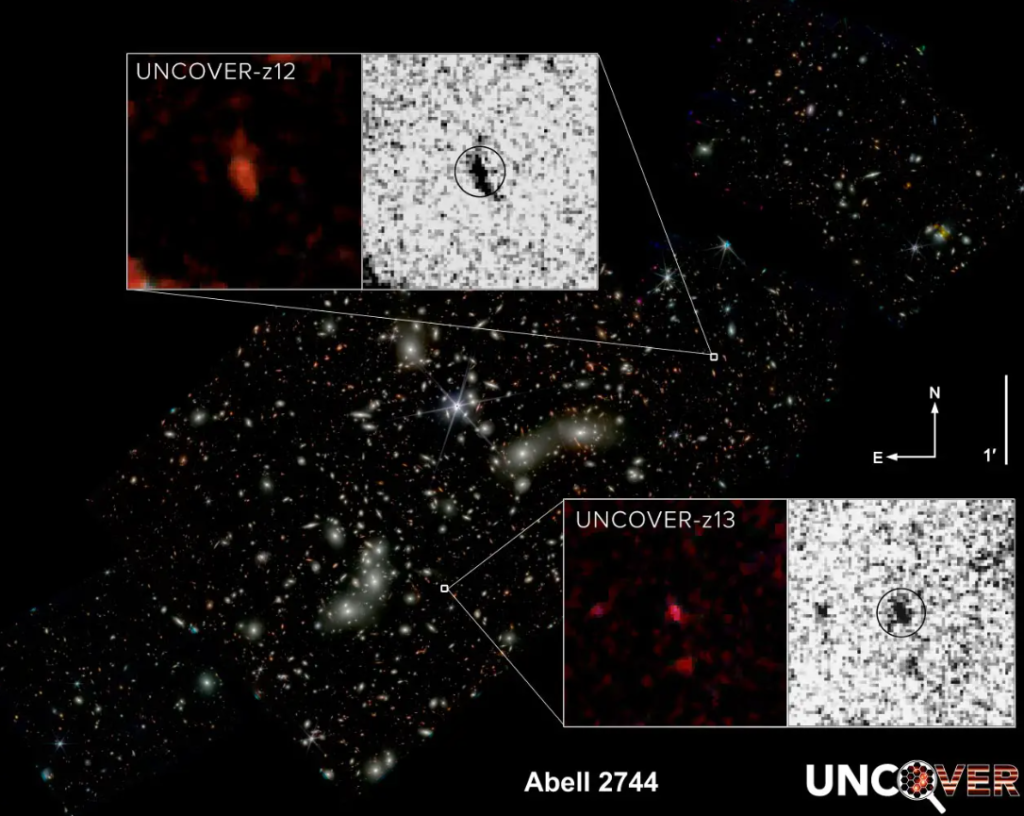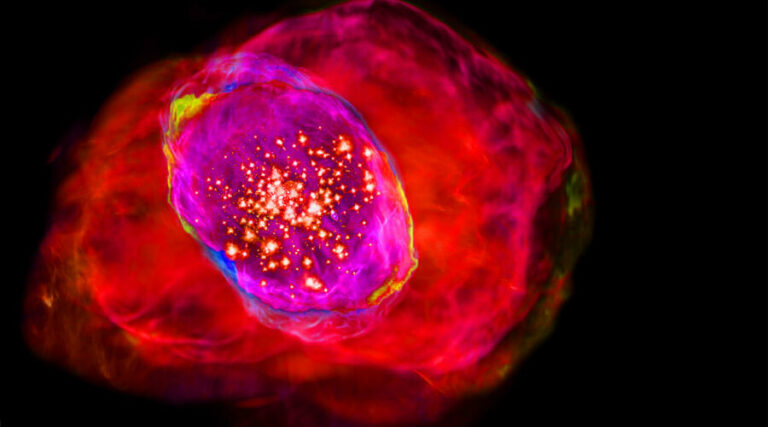James webb space telescope discovered galaxies 33 billion light away
Led by Penn State researchers, an international team used JWST’s spectroscopic data to confirm distances and explore properties. These ancient galaxies, located about 33 billion light years away, offer crucial insights into the formation of early galaxies.
Unique Appearance and Significance
In contrast to other galaxies established at this distance, which manifest as red dots in images, the recently discovered galaxies exhibit distinctive characteristics – one resembling a peanut and the other akin to a fluffy ball, as outlined by the researchers. The details of these galaxies are presented in a paper published today (November 13) in the journal Astrophysical Journal Letters.
“Very limited information is available about the early universe, and the sole means to delve into that era and assess our theories of early galaxy formation and growth is through these exceedingly distant galaxies,” remarked Bingjie Wang, the first author of the paper. Wang serves as a postdoctoral scholar in the Penn State Eberly College of Science and is a member of the JWST UNCOVER team responsible for the research.
“Before our analysis, only three galaxies were known to be confirmed at approximately this extreme distance. The exploration of these recently identified galaxies and their distinctive characteristics has brought to light the diverse nature of galaxies in the early universe, highlighting the wealth of knowledge that can be gleaned from them.”

Insights Into Early Universe
Because the light emitted by these galaxies had to traverse vast distances to reach Earth, it serves as a portal into the past. According to the research team, the light captured by JWST originated from the two galaxies when the universe was approximately 330 million years old, embarking on a journey of about 13.4 billion light years to reach the telescope. However, due to the expansion of the universe during this time, the researchers estimate that these galaxies are currently positioned closer to 33 billion light years away from Earth.
Joel Leja, assistant professor of astronomy and astrophysics at Penn State and a member of UNCOVER, noted, “The light from these galaxies is ancient, about three times older than the Earth. These early galaxies act as beacons, emitting light through the extremely sparse hydrogen gas that constituted the early universe. It is solely through their light that we can start to unravel the exotic physics that governed galaxies near the cosmic dawn.”
Significantly, the two galaxies surpass the size of the three galaxies previously identified at such extreme distances. One of them is at least six times larger, spanning about 2,000 light-years across. While the Milky Way measures approximately 100,000 light-years across, Bingjie Wang pointed out that the early universe is believed to have been highly compressed, making the galaxy’s substantial size surprising.
Wang remarked, “Previously discovered galaxies at these distances appeared as point sources—dots in our images. However, one of ours has an elongated appearance, almost like a peanut, while the other resembles a fluffy ball. The reason for the difference in size remains unclear, whether it is related to how the stars formed or their subsequent evolution. Nevertheless, the diversity in the properties of these galaxies is intriguing. Despite being expected to form from similar materials, these early galaxies are already displaying distinct differences from one another.”
Research Methodology
The two galaxies were identified among the 60,000 sources of light within Pandora’s Cluster, as captured in one of JWST’s initial deep field images taken in 2022, marking its inaugural year of scientific operations. This specific region in space was chosen partly due to its location behind various galaxy clusters, resulting in a natural magnification phenomenon known as gravitational lensing. The collective gravitational force of these clusters distorts the space around them, concentrating and amplifying light passing nearby, thereby offering an enhanced view behind the clusters.
Over a span of months, the UNCOVER team whittled down the 60,000 light sources to 700 potential candidates for further investigation, identifying eight that could potentially be among the earliest galaxies. Subsequently, JWST focused on Pandora’s Cluster once again, recording the spectra of these candidates—a kind of fingerprint that outlines the amount of light emitted at each wavelength.
Joel Leja, commenting on the various approaches employed by different teams in the quest for ancient galaxies, stated, “The fact that we’re pointing at this giant magnifying lens in space gives us an incredibly deep window, but it’s a very small window, so we were rolling the dice. Several of the candidates were inconclusive, and at least one was a case of mistaken identity—it was something much closer that mimics a distant galaxy. But we were lucky, and two turned out to be these ancient galaxies. It’s incredible.”
Properties and Implications
The researchers employed detailed models to deduce the characteristics of these early galaxies at the time they emitted the light detected by JWST. As anticipated, the two galaxies were found to be youthful, with a low metal content in their composition, and were actively undergoing rapid growth while actively forming stars.
Joel Leja explained, “The first elements were forged in the cores of early stars through the process of fusion. It makes sense that these early galaxies lack heavy elements like metals because they were among the initial factories responsible for producing those heavy elements. Additionally, they would need to be young and in the process of star formation to qualify as the first galaxies. Confirming these properties represents a crucial fundamental test of our models and contributes to validating the entire framework of the Big Bang theory.”
The researchers highlighted that, coupled with the gravitational lens, JWST’s potent infrared instruments have the potential to detect galaxies at even greater distances, assuming they exist.
Joel Leja noted, “We had a very limited view into this region, and we did not observe anything beyond these two galaxies, despite the capabilities of JWST. This could suggest that galaxies did not form before that time and that we might not discover anything farther away. Alternatively, it could mean that our small observational window did not capture more distant galaxies.”
This research stemmed from a successful proposal submitted to NASA outlining how to utilize JWST during its initial year of scientific operations. During the first three submission cycles, NASA received four to ten times more proposals than the available observing time on the telescope would permit, necessitating the selection of only a fraction of those proposals.
Joel Leja expressed the team’s excitement and surprise at the acceptance of their proposal, stating, “It involved coordination, prompt human action, and the telescope pointing at the same thing twice, which is a significant request for a telescope in its first year. There was a lot of pressure because we only had a few months to determine the objects for follow-up. However, JWST was designed to discover these first galaxies, and it’s incredibly exciting to be actively engaged in that pursuit now.”
Sources:
“UNCOVER: Illuminating the Early Universe—JWST/NIRSpec Confirmation of z > 12 Galaxies” Published 13 November 2023, The Astrophysical Journal Letters;
DOI: 10.3847/2041-8213/acfe07
Do not forget to share your opinion with us to provide you with the best posts !




0 Comments